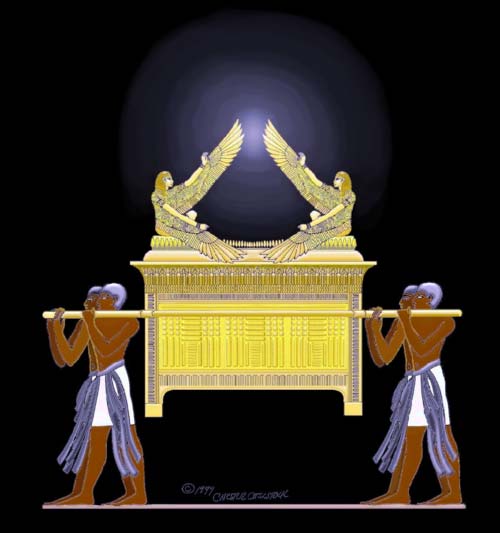The cherubim are a class of angelic beings mentioned in the Bible, and in various ancient Near Eastern cultures. They are identified in the Bible first as guardians of the tree of life (Genesis 3:24), or simply as being in Eden (Ez. 28:13-14). In later passages they are depicted as guardians of the throne of God (Ex. 25:17-22; 1 Kings 6:23-28; Ex. 26:31; Ez. 1:26, Ps. 80:1, 99:1; Is. 37:16; Dan. 3:55), or are described as being modes of transport for God Himself (2 Sam. 22:11; Ps. 18:10; Ez. 10:18-19).
As noted in some of the passages above, both two-dimensional and three-dimensional images of cherubim adorned the Tabernacle and Solomon's Temple: on the lid of the Ark of the Covenant, on the entrance to the Holy of Holies, standing on either side of the Ark itself, and on the interior walls of the Temple.
The image of cherubim as throne guardians was widespread throughout the rest of the Near East during the time of ancient Israel, but it was most common in Syria and Northern Mesopotamia between 2000 and 700 B.C. (Solomon built his temple to Yahweh in 960 B.C.).
So how were cherubim depicted artistically in ancient times? Well, not at all like the putti of later European art! The cherubim of the ancient Near East were composite creatures, part human and part animal, often four-legged. Although there was a lot of variation in how they were depicted, the common trait they all shared was wings, though the number of wings could vary. A few were depicted as humans with wings. According to W. F. Albright, there was “in Egypt the wingless sphinx and the griffin... in Babylonia and Assyria the winged bull with a human head prevails; but in Syria and Palestine it is the winged sphinx which is dominant in art and religious symbolism" ("What Were the Cherubim?" in The Biblical Archaeologist, Feb., 1938).
Perhaps the most famous pair of cherubim in the Bible are the two on the lid of the Ark of the Covenant. The Ark was the object above which Moses would “meet” with God in the Tabernacle (and later by the High Priest in Solomon's temple). It was a gold-covered wooden chest which contained the tablets of the ten commandments (as well as Aaron's rod and manna). In the Bible, the ark functioned as a kind of throne or footstool for Yahweh. Interestingly,
in Egypt it was common for important documents that were confirmed by oath (e.g., international treaties) to be deposited beneath the feet of the deity... therefore, the footstool/receptacle combination follows known Egyptian practice. In Egyptian festivals the images of the gods were often carried in procession on portable barques. Paintings portray these as boxes about the size of the ark carried on poles and decorated with or flanked by guardian creatures. A similar-sized chest with rings (for carrying with poles) was found in Tutankhamen's tomb (IVP Bible Background Commentary: Old Testament, p. 106).
Other examples of cherubim thrones in or near Israel have been found at Byblos, Hamath, Megiddo, Arslan Tash, Carchemish, and Samaria all dating between 1200 and 800 B.C. Another example (missing most of the cherubim) was found in southern Turkey.
Next week: more on the temple as the Garden of Eden.



No comments:
Post a Comment